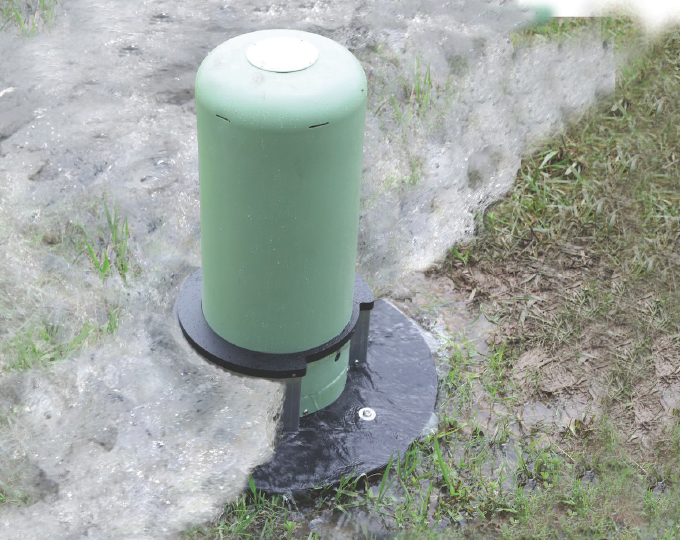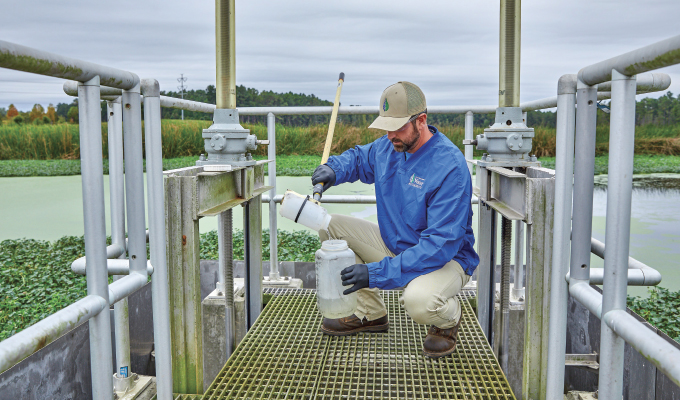Flushing of water distribution systems is critical to ensure customers receive the best water quality. Aging infrastructure, poor quality pipelines, and high temperatures are all contributing factors to scale and biofilm building up inside pipelines. An important maintenance task is to ensure water is thrust through the system at a decent velocity to clear out stagnant water. Dead-end mains, typically in cul-de-sacs, at the end of rural streets, or even in a looped line, are known problem areas for water stagnation. Residential neighborhoods under construction and large underpopulated developments often have slow-moving or stagnant drinking water.
Mueller Water Products is North America’s largest and only full-line supplier of potable water distribution products, which includes an extensive line of water flushing solutions. In this interview, we hear how two of Mueller’s customers address the challenges of water main dead ends. Steve Lovato, system quality supervisor for Denver Water, and Brian Bianchi, senior project manager of Wilkinsburg-Penn Joint Water Authority, provide information on how to prevent water quality issues in the distribution system.
WHY DO DISTRIBUTION LINES NEED TO BE FLUSHED?
Steve Lovato: In general, distribution lines need to be flushed to maintain water quality in the system. Distribution systems are a complex system of pipes, pumps, valves, and tanks. Sediments and deposits can accumulate naturally. Flushing helps the system maintain clarity, reduce biofilm, and prevent bacteria buildup. It keeps the water fresh, clear of any sediment, and helps to maintain chlorine residuals and avoid bacterial growth. Flushing the distribution system reduces water quality issues and complaints.
WHAT SPECIAL PROBLEMS OCCUR IN WATER MAIN DEAD ENDS?
Brian Bianchi: Water tends to stagnate in dead-end pipes. This leads to a loss of chlorine, a buildup of sediment, and increased water age. Areas where dead-end mains are located tend to have customer complaints about taste, odor, and water discoloration.
Steve Lovato: Also, nitrification can occur in the pipe, which reduces chlorine residual further, resulting in bacterial growth.
HOW DO AUTOMATIC FLUSHING SYSTEMS WORK?
Brian Bianchi: We have eight units throughout the distribution system. They can be programmed to turn on seven days per week for a set number of minutes. We determine the flush time based on the diameter and length of pipe. We also review customer complaints to see where problems exist in the system. Our units have an electronic control valve that allows water to pass through. We remove the filler pipe and install a 1-inch meter to measure the water loss, as we’re being proactive to reduce unaccounted-for water. These automatic flushing units are extremely reliable. They run off a nine-volt battery that we replace once per year—very impressive for an electronic device.
Steve Lovato: Our four automatic flushing units are in northeast part of our service area at the furthest points in the distribution system. We can set them to flush on a specific day and set time. They can also be set to flush a specific number of gallons per minute.
CAN AN AUTOMATED FLUSHING SYSTEM DECHLORINATE THE WATER IF NEEDED PRIOR TO DISCHARGE?
Brian Bianchi: Yes, our Hydro-Guard® HG-8 units come with a dechlorinating chamber that holds a number of tablets. Dechlorination with our units must be turned on and off manually with a valve, and we can set the amount of water to pass through. Our units do not sense the level of chlorine, but newer SMART units are capable of monitoring the amount of chlorine and dechlorinating as needed.

WHAT ARE THE ADVANTAGES OF AN AUTOMATIC FLUSHING SYSTEM?
Steve Lovato: The automatic flushing system saves a lot of man-hours. The time to drive to a remote site, open and flow the hydrant, and come back can total three hours. It helps with consistency, too. We know the flushing will be done on time, consistently, flowing at a constant rate. Flushing at a lower but consistent rate prevents sediment from breaking off the pipe and causing complaints. Also, the automatic flushing system prevents high-velocity flows that can cause pressure problems. Another issue is safety. The areas where we use the automatic flushing units are difficult to access. Trucks get stuck in the mud, and the crew is exposed to snakes, traffic, and other hazards.
Brian Bianchi: The biggest advantage is the ability to flush trouble spots at regular intervals without having to allocate resources to flush manually. This is especially important in low-flow areas and where water mains dead end. The programmable feature is great. We can turn the units on and off based on our needs. We can run the system one hour per day or one hour every three days. It takes human error out of the picture.
The lack of visibility is another advantage. The flushing is concealed by flowing directly into a drain pipe, which reduces customer calls about wasting water or wondering if something is wrong. Reliability and safety are very important also. Employees don’t have to work near or in the roadway. And in the winter, water does not freeze on the road surface, nor does ice form in an intersection at the bottom of a hill.
CAN THE FLUSHING ACTIVITY BE REMOTELY CONTROLLED, MONITORED, OR RECORDED?
Steve Lovato: Newer units can be, but we’ve had our units for thirteen years. We have SCADA set up at the remote areas to monitor chlorine residual. This gives us a good indication of how to set flushing times. We monitor residuals on a daily basis. If we see the chlorine level dropping, we set the timer for longer intervals.
Brian Bianchi: Our automatic flushing units are manually set. “SMART units” are available that can be remotely controlled and can monitor chlorine residual, pH, turbidity, flow, and temperature.
WHY IS AUTOMATED FLUSHING SPECIFICALLY BETTER FOR WATER MAIN DEAD ENDS?
Steve Lovato: Because you can be more consistent. You can set the units to flush at a specific rate. If a hydrant is opened to full flow, it discharges at over 1,000 gallons per minute. We run our automatic flushing units at 70 gallons per minute. Flushing at that rate prevents scouring the pipe interior. It also avoids putting too much pressure on a pipe or causing water hammer. Flushing at a reduced rate avoids pooling of water, filling ditches, and causing erosion.
Brian Bianchi: Automatic flushing provides the opportunity to consistently move water at dead ends versus manually flushing as needed. It eliminates callouts for water quality complaints and avoids some of the headaches of manual flushing, like a car parked in the way or getting an emergency call in the middle of flushing.
ARE THERE ANY SPECIAL CONSIDERATIONS FOR FLUSHING DEAD-END WATER MAINS?
Brian Bianchi: When it comes to flushing old cast iron pipes, slow and steady wins the race. With manual flushing out of fire hydrants, you can move water from the pipe fast and clean the pipe quickly. But the ripple effect is that sediment is stirred up, and you still have complaints. With the automatic units, a one-inch line is used for flushing, resulting in less complaints.
Steve Lovato: We use our automatic units in the remote areas where we flush into fields. One of our concerns with manual flushing is eroding the land. Also, one of our system’s furthest points is at Denver International Airport. We have to be especially careful not to over-flush and create “wetlands” as it can attract birds which are a serious hazard near an airport. Automatic flushing avoids that problem.
HOW CAN AUTOMATED FLUSHING HELP TO PREVENT THE FORMATION OF DISINFECTION BYPRODUCTS IN WATER MAIN DEAD ENDS?
Brian Bianchi: With automatic flushing, we’re able to turn the water over, especially in areas where there’s not a big demand. The automatic system improves water quality.
Steve Lovato: Mainly, the automatic flushing units maintain water quality so nitrites don’t build up. Also, we maintain chlorine residual in the distribution system.
Mueller Water Products is a leading manufacturer and marketer of products and services used in the transmission, distribution, and measurement of water in North America. The company’s broad product and service portfolio includes engineered valves, fire hydrants, metering products and systems, leak detection and pipe condition assessment. It helps municipalities increase operational efficiencies, improve customer service, and prioritize capital spending, demonstrating why Mueller Water Products is “Where Intelligence Meets Infrastructure.” For more information, visit www.muellerwaterproducts.com.
MODERN PUMPING TODAY, May 2019
Did you enjoy this article?
Subscribe to the FREE Digital Edition of Modern Pumping Today Magazine!



